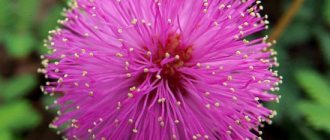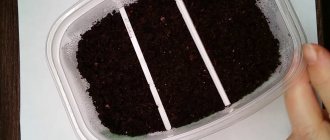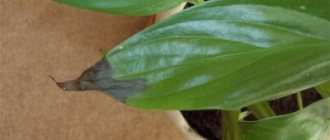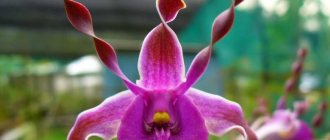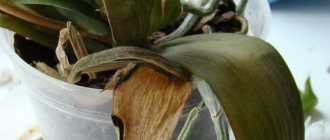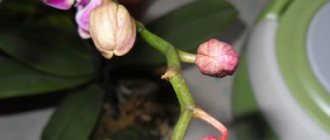It happens that or young sprout begins to rot Without paying attention to this, you can quickly lose the plant.
There is also no need to rush to throw away a flower; you can still cure it and subsequently admire the flowering.
Where is the growing point of various orchids? In monopodial orchids, the growth point is the top of the trunk , from which the leaves grow. These orchid species have only one growth point, and when it dies, the plant stops growing.
Growth point of a monopodial orchid.
The sympodial group is distinguished by the fact that it has several growth points , giving the orchid the opportunity to develop further if one of them dies.
Growth point of sympodial orchids.
Below we will tell you about various problems with the orchid’s growing point (no, it’s rotten).
Orchid growth point - what is it?
This is the vegetative part of orchids. With its help, new leaves, side shoots, and flower buds develop.
Its location varies depending on the structure of the root system:
- In monopodial plants it is located in the recess between the apical leaves. It remains in this form until the beginning of the growing season. Then it turns into light green shoots at the top of the flower.
Monopodial species: Phalaenopsis, Vanda.
- Sympodial orchids have several growth points. They appear and die throughout the life of the plant. These points represent shoots on which pseudobulbs grow. After flowering, the formed shoots stop growing, and the point dies.
Sympodial species: Cattleya, Dendrobium, Oncidium.
The monopodial type includes plants with one main vertical shoot. Sympodial plants develop from a horizontal shoot - a rhizome, which annually produces new shoots. They form their own pseudobulbs, leaves, peduncles and flower buds or vegetative shoots.
The appearance of the "Snake Head"
Very rarely, in monopodial orchids, a snake head appears from the growing point - this is a peduncle . This happens because the life period for this plant is ending.
The appearance of a peduncle is an attempt by the flower to continue its existence in the offspring.
In this case, it is legal to use Cytokinin paste to get a baby. It should be borne in mind that its use does not guarantee the appearance of a baby , but it does give a chance. First of all, the orchid must be given the opportunity to bloom. Further:
- Trim the peduncle 1 cm above the first dormant bud;
- Carefully remove the covering scale;
- Using a disinfected needle, carefully apply 3-4 scratches to living tissue;
- Using the same needle, apply a little paste to the kidney, remove excess;
- After 7-10 days the kidney will wake up.
Important! Damage to a growing point does not mean the death of the entire plant.
Why does an orchid need it?
Thanks to it, during the active growing season, leaves, aerial roots and peduncles appear - all these parts communicate with each other and form a single system. That is, growth points develop the plant and create the prerequisites for the full functioning of the orchid:
- nutrition - with the help of leaves and aerial shoots.
- reproduction - with the help of children developing from buds on flowering shoots.
Therefore, for monopodial plants (for example, for the Phalaenopsis orchid), the absence of a rosette tip threatens death. The growth of the flower stops, it becomes unable to obtain nutrients.
For a sympodial orchid, its absence is not so dangerous. One shoot stops growing, but the rest continue to develop. This should not be ignored. If the area where new shoots ripen is affected by rot, the disease can spread to healthy tissue of the flower and to other plants. This is also evidence of inappropriate living conditions or illiterate care.
Consequences
The most dangerous thing is when the flower begins to rot from the middle, because a large number of orchid varieties have only one growth point. If it dies, the plant will not be able to continue development, and then dies.
Also, when the core or neck rots, the orchid loses its foliage. The leaves become soft and less elastic. They fall off the stem, and the plant folds up like a construction set. Next, the root system is damaged. For details on how to save an orchid if the roots are deteriorating or have already rotted, read this material.
If there is excess air humidity in the room, the affected areas of the plant become overgrown with rot spores, which can spread to nearby flowers. If emergency measures are not taken in time and the cause of the spread of rot is eliminated. Only in this way can an orchid be saved from imminent death. After all, in the later stages nothing will help.
Why is there no growth point?
If the growth point is damaged or disappears, this is expressed in the following signs:
- At the initial stage, the leaves become yellow and fall off, but new ones do not grow.
- If it has been missing for a long time, the rosette consists of two or three lower leaves. The upper part is missing, and in its place a dried “stump” is visible.
- A fungus forms on the upper sinuses.
There are several factors influencing the abnormal development of the growth point. All of them are associated with errors in plant maintenance or illiterate care.
Rotting of the growing point
Orchids prefer high humidity and abundant watering to drought. Therefore, they are easy to “fill in”. The plant may rot if watering rules and humidity requirements are not followed. The basis for the shoots begins to rot if:
- The room has high humidity but low temperature. Moisture evaporates over a long period of time, which can cause the socket to rot.
- Lack of ventilation.
- When watering or spraying, water got into the rosette and leaf axils.
Rotting of the top of an orchid rosette manifests itself in the following:
- The structure and color of the leaves changes. They become soft, pliable, lose turgor, and acquire a brown tint at the base.
- Dark spots appear on the trunk.
- The above-ground part of the flower loses its stability.
- In advanced cases, the upper leaves fall off.
In addition to non-compliance with maintenance conditions, the core can rot due to mechanical damage. For example, if you leave them without antiseptic treatment.
Mechanical damage
The top of the socket can be damaged under various circumstances:
- Incorrect placement of the flower - if the orchid pot needs to be rearranged frequently, the risk of it falling is high. Therefore, you should choose the only place where the plant will be comfortable.
- Turning the pot over - plastic pots are often unable to hold a flower. Therefore, they are weighed down or placed in transparent, heavier pots.
- When replanting - when removing an orchid from a pot, you should not pull on the top of the plant. It is better to swing it from side to side at the base, slightly pulling it up.
It’s easy to avoid mechanical damage if you think about its location in advance, choose the right pot and prepare for replanting.
Sunburn
Exposure to sunlight can damage the top shoots of orchids. Most species are placed in well-lit places, but do not allow plants to be in bright sun.
On sunny days, spraying and watering using the “hot shower” method are also not carried out. Drops of water accumulating in the axils of the upper leaves and near the buds can cause burns. Therefore, watering and spraying is carried out either in the early morning or in the evening. The moisture on the plant must dry before the sun comes out.
Most often, the sun's rays affect the upper leaves, which do not affect the core. The danger arises during the active growing season, when tender leaves bloom at the growth site. They are susceptible to burns even from short exposure to the sun.
Damage by diseases and pests
The growing point may die if the orchid becomes infected with fungal or infectious diseases. The plant is susceptible to diseases if it is not cared for properly (overwatering, lack of light, grown in a draft) or if it is infected from other flowers.
Harmful insects worsen the condition of the plant, weaken it, and make it susceptible to infections. Orchids are attacked by aphids, mealybugs, scale insects, spider mites and thrips. Therefore, if there are diseases, you should inspect the flower for pests. Fungicides are used to get rid of insects.
Cylinder
Deformed development of an orchid, in which the peduncle grows from the place of the growth point. It will no longer be able to grow leaves or grow in height. But babies can form in place of the outlet.
To stimulate the emergence of a new growth site, young buds are treated with hormonal drugs, for example, cytokinin paste.
Hormonal drugs are used with caution - their overdose suppresses plant development.
Preventive actions
To avoid having to treat your home plant for rot, follow simple rules for caring for your orchid.
Firstly, select a suitable place to keep the flower. It should be well lit and well ventilated. Secondly, the flower is protected from sunlight. Thirdly, to prevent the leaves and core of the plant from rotting:
- Monitor watering moderation. The need to moisten the soil is determined by its condition. Watering is organized after the soil has completely dried.
- Monitor the dryness of the plant foliage. After 30-40 minutes. After spraying or watering, wipe the leaves with a moisture-absorbing sponge (a dry cloth will also work).
- When transplanting plants, the soil is disinfected. They use boiling water treatment or, in the case of granulate, calcination in a frying pan.
- Monitor temperature and humidity in the room. Cool air and its high humidity increase the risk of flower rotting.
Orchids rot only in a weakened state. With proper care, such problems can be avoided.
What to do if the orchid does not have a growing point
The process of resuscitating a flower without this vegetative part takes a long time. The result of treatment is not known in advance. It depends on how quickly actions are taken to save the plant, what is the constant care and maintenance during the recovery period.
Identifying and eliminating causes
Treatment should begin by correlating the maintenance requirements with the actual growing conditions. The most common reason for the death of the escape base is illiterate care.
- If it has rotted, the watering regime, humidity and temperature should be brought back to normal.
For Phalaenopsis, the optimal summer temperature is 20-25 degrees, winter - 16-18 degrees. Humidity is maintained at 60-80%. The lower the temperature, the less moisture the plant requires.
- In case of mechanical damage or burns, the broken or affected areas are cut off with a sharp knife. Then the cut areas are disinfected - sprinkled with ground cinnamon or crushed charcoal.
The instrument used to perform the procedure should be doused with boiling water or wiped with alcohol.
If there is no visible damage to the growing point, but the upper leaves dry out and turn yellow, and there is no new growth, the conditions of maintenance should be improved. The pot with the flower is moved to a more illuminated place, and stimulating watering is carried out using the “hot shower” method. Water for irrigation - about 35 degrees.
The procedure will bring the plant out of a stressful state, due to which the root system and foliage will begin to grow. In order not to provoke rotting of the orchid core, you need to follow certain rules:
- After a shower, you should not put the plant in a cold room. You should leave it in the bathroom overnight.
- After the procedure, the moisture that has entered the core needs to be blotted into the axils of the leaves.
Oncidiums and Cambrias react negatively to excessive moisture. For them, a “hot shower” is not used.
The opposite way to “wake up” a flower is to place it in cool conditions. To do this, the temperature is reduced to 10 degrees for a short period.
Features of care and maintenance
The orchid's maintenance regime will have to be adjusted .
The plant must be moved to a bright place, but avoid direct sunlight. For the first couple of weeks, the orchid does not need to be watered with fertilizers and stimulants, you just need to observe. Why? We must be completely sure that the defeat has not gone further and the process has stopped.
Moreover, feeding during illness will do more harm than good.
After the control time has passed, you can begin to treat the orchid with stress stimulants:
many other stimulants on the market , but before using them, you need to familiarize yourself with what exactly they stimulate - a wounded plant does not need stimulation of flowering at all. Ointment is used as a growth stimulator.
Spraying the plant with biostimulants is excluded, due to the fact that moisture entering the growth point is fraught with relapse . You can water the flower or make lotions using cotton pads. The use of succinic acid is very effective: 1 tablet per 1 liter of water.
Succinic acid helps to restore the growth point well.
High humidity can also trigger re-rotting . The temperature should be relatively even: +20-24 degrees during the day with a slight drop at night.
The appearance of a baby or the activation of a dormant bud depends, first of all, on the general condition of the orchid. If the plant was healthy and strong before losing its growth point, then after 1-1.5 months the orchid will continue its development .
Otherwise, especially if the cause of the loss of growth point was Fusarium, further development will begin only after complete recovery . The probability of a positive outcome is 50/50.
Treating orchids for rot
Plants affected by fungal diseases and rot are the most dangerous. Fungal spores quickly spread through tissues and can also infect other plants. To get rid of the disease, you need:
- Using a sharp knife, remove all rotten parts of the orchid to the healthy green pulp.
- Treat sections and exposed tissue with a disinfectant. It can be replaced by cinnamon powder, activated carbon, a solution of brilliant green or iodine.
- Allow all treated areas to dry.
- Treat the soil and the plant itself with a fungicide.
For this purpose, Fitosporin-M is used at the rate of 100 ml per 1 liter of water. In case of severe damage, take 200 ml of water per 100 ml of product. The drug is diluted in purified water at room temperature.
Another fungicide effective against rot is a low concentration solution of copper sulfate. For 500 ml of water, take several crystals - on the tip of a knife. Antiseptic is used for adult orchids. Treatment of young flowers is carried out with Bordeaux mixture, which is diluted at the rate of 4 ml of product per 10 liters of water.
Repeat the disinfection procedure two or three times within 2 weeks.
If the decay can be stopped, optimal growing conditions are created for the orchid.
How to treat rotting at home?
To help an exotic plant and choose the right treatment, you should first determine the cause of the rot, and only then use this or that remedy.
Chemical
If it turns out that the cause of rotting of the root system is pests (whiteflies, midges, scale insects, thrips) or viral diseases, then acaricides or insecticides will be useful, such as:
- "Aktara";
- "Tsvetofos";
- "Fufan";
- "Inta-vir";
- "Vermitek".
For fungal infections, fungicides are indispensable. The most effective drugs for prevention and treatment are fungicides, which destroy pathogens of fungal diseases in flora. They come in different spectrums of action. The main active substances of fungicides are: aldehydes, mercury, copper, manganese, organic substances.
- "Oxychom";
- "Fundazol";
- "Immunotitophyte";
- "Fitosporin";
- "Topas".
Folk
What can you do at home to save rotting roots? Homemade recipes are products that have been proven over the years. Yes, they do not have the same degree of damage as industrial ones, but they are more affordable and environmentally friendly.
- A decoction of cyclamen tubers. For preparation you will need finely chopped flower tubers. It is recommended to boil them over low heat for 30-40 minutes. Leave for a day. Afterwards, strain the broth and dip the diseased orchid roots into it for 5-10 minutes.
- Soap solution. Dissolve 1 bar of laundry soap in 3 liters of clean warm water. Then immerse the roots in the soapy solution for a few minutes.
- Oil solution. Dissolve 2 tablespoons of olive oil in 1 liter of water. You can immerse the orchid roots in the resulting mixture.
- Onion infusion. Cook 3-4 small onions for 30 minutes. Then cool the broth and leave for a day. Clean flower roots should be left in the medicinal liquid for 7-10 minutes.
Important. Folk remedies can only help in the early stages of the disease.
Plant restoration
During the restoration of the orchid, the room temperature is set at 25-26 degrees. Watering is stopped. Resume 2-3 weeks after treatment. The application of fertilizers is excluded; they force excessive consumption of accumulated energy.
After a month has passed from the date of pruning the orchid, it can be treated with growth stimulants. The following products are suitable:
- Zircon - intended to relieve stress in plants, restore immunity after diseases, including fusarium. The drug stimulates root formation and helps protect against pests.
- Succinic acid is used as an anti-stress agent, thanks to which the orchid’s immunity is restored. It helps absorb nutrients from the soil and makes the root formation process faster.
- Epin-Extra – activates the protective functions of the flower, strengthening the immune system, stimulates the growth of the root system, “awakens” the plant. The effect of using the product is not immediately noticeable; first, nutrients accumulate for subsequent growth.
The drugs are applied at the root. Spraying can cause repeated rotting of the top. Some formulations (for example, Epin-Extra) are better absorbed by the leaves, which is why it will not be possible to avoid spraying. Therefore, when processing leaf by leaf, moisture should not be allowed to enter the rosette and leaf axils.
If the plant produces a peduncle during the recovery stage, it should be pruned. Otherwise, the orchid will direct all its energy to forming buds and die.
At this stage, you should provide sufficient lighting, but do not leave the orchid in the sun. If the procedure is carried out in winter, additional lighting must be turned on.
A cured orchid forms a new growth point, thanks to which it continues to develop and bloom.
Phalaenopsis after a cat attack
Many novice orchid growers are shy in front of orchids. The Internet is flooded with: “Oh, help, the leaves are turning yellow, the flowers are dropping, they are dying.” Tips: “stress after the store, overfill, underfill, too much sun, not enough sun, wrong substrate - shavings, not bark, pull out, dry for a day, replant in bark.” In general, I believe that phalaenopsis is the most unpretentious plant for beginners in home gardening. Yes Yes Yes!!! Do not be surprised.
We have the sun from 12 o'clock until it completely sets below the horizon, i.e. in summer it’s hot and stuffy until 2-3 o’clock in the morning, until the house gives up all the heat. I'm all about business, leaving early and coming late. I water my phalaenopsis more than once a week, and sometimes even every 3-4 weeks (to be honest, it’s according to my mood: “I haven’t watered something for a long time - I need to water it”). I have phalaenopsis in my kitchen; besides them, there are no other plants there - because my cats have not touched phalaenopsis before, and they gnaw other orchids. For example, cattleyas live in a large room that can be closed.
I now have six phalaenopsis. I talked about one of them above - how it recovered six months after water hit the growth point. I’ll tell you about the second phalaenopsis, which was recently attacked twice by my cats, previously loyal to phalaenopsis. I don’t know what they suddenly didn’t like about this plant, but as a result they almost pulled it out. I saw that the torn phalaenopsis was hanging over the edge of the pot. I put it on a pot with the intention of replanting it over the weekend. And as a result, the next weekend there was no time for the orchid, the next weekend it was overwhelmed by other important problems, and this happens... For a couple of weeks, the phalaenopsis lived with 2-3 roots hooked onto the bark, and the rest of the roots outside. Finally, when I got around to transplanting the phalaenopsis, its leaves even wrinkled a little. Now, just a few days after the transplant (even the leaves have not yet acquired normal turgor), this growing phalaenopsis has already begun to develop a peduncle!
When I watered my orchids for the last time, I just noticed that the third, most powerful phalaenopsis had a peduncle that had already reached 15 cm. True, this peduncle does not grow upward, but sideways towards other orchid friends, but it does grow! This means that my phalaenopsis has enough moisture, attention, and light. This is such an idyll...
The main conclusion: you have to try very, very hard to kill phalaenopsis. The flower knows that you love it, but excessive daily attention is harmful for the orchid.
